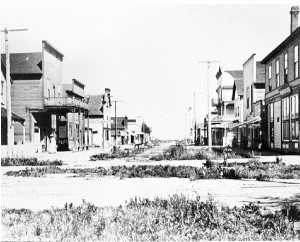Steveston losing small-town feeling?
January 13, 2010 by Katie Lawrence · Leave a Comment

Moncton Street in Steveston in 1906. (Photo courtesy of the Richmond Archives)
The fishers have laid out their catches and are selling them to the locals walking the Steveston docks on a Saturday morning. Many kinds of fish and seafood, including crab, prawns and halibut, are on display, along with the boats that crowd Fisherman’s Wharf. This has been a source of income for seamen since Steveston was first founded as a fish- ing village in 1890. There is a smalltown feeling to it all.
Turn around though, and you might get a different feeling. The other side of the wharf is loaded with restaurants and shops for the tourists. Walk a block to the east and you see three coffee houses — Blenz, Starbucks and Waves — all within one glance. A block north, there’s a McDonald’s nestled into the old train-station building across from Steveston Park and Community Centre. With more commercial development moving into the Richmond subdivision, there are those who think the sense of community in Steveston is getting lost. Given that it’s one of Richmond’s first neighbourhoods, some feel that the “gritty†feel of Steveston should be a priority.
Dave’s Fish and Chips’ manager Bryan Scott is one of them. “[The development] is becoming a little
too much. The way it’s being built is taking away from the overall appearance of Steveston,†Scott said.

Present-day Moncton Street in Steveston. (Katie Lawrence Photo)
“There were lots of older buildings that were one storey and and now there are two-storey buildings with the apartment above. It’s becoming bigger than it should,†added Scott, who has worked at Dave’s for 17 years.
Dave’s has been in Steveston since 1978 and although it’s moved a couple of times, business has been pretty solid, even after McDonald’s opened just down the road.
Scott said that McDonald’s moved in at a time when a lot of apartments were being built and more people started to live in Steveston.
Development might not be that bad, said Terry Crowe, manager of the Policy Planning Division for the City of Richmond and member of the Richmond Heritage Commission.
Crowe said that of the 90 buildings in Steveston Village, only 17 are protected by the Steveston Area Plan, a heritage-conservation strategy. The other 73 buildings can be demolished or changed in any way. The 17 protected buildings cannot be knocked down and the exteriors must comply with the 14 federal heritage standards set by Parks Canada.
According to the Parks Canada Standards and Guidelines Report, some of those standards are:
- Conserve the heritage value of a historic place. Do not remove, replace or substantially alter its intact or repairable character-defining elements. Do not move a part of a historic place if its current location is a character-defining element.
- Conserve changes to a historic place which, over time, have become character-defining elements in their own right.
- Find a use for a historic place that requires minimal or no change to its character-defining elements. The exteriors of the buildings must stay the same, but the interiors can be altered.
“We’re just interested in the exteriors of the buildings. We don’t care what is done with the insides, so that gives the village a lot of flexibility,†Crowe said.
Dave’s Fish and Chips is one of the protected buildings. The structure itself is made up of brick and wood with two bright-blue doors and big bay windows facing Moncton Street. On the east side of the building, there’s a take-out section and some picnic benches.
Another one of the 17 heritage buildings is the post office/museum, which looks like an old house sitting on the corner of Moncton and First Streets. It was Steveston’s first bank, built in 1905. The top half of the building is painted burnt orange, the bottom is a creamy yellow. The house exterior is accented by thick, white trim. There is a park in the back that is shaded by leafy trees in the summer. The outside of the building has been preserved to match the federal heritage standards, but the inside is a functioning post office and museum dedicated to Steveston’s history.
Crowe also explained that some of the 73 buildings not protected by the Steveston Area Plan are privately owned, so the City of Richmond cannot decide what businesses can move into that space.
“It’s like when an apartment is built. The city cannot pick and choose who the tenants are,†said Crowe. “The City does not interfere with privately leased spaces. I get that there’s some anti-McDonald’s opinions and all that, but the City has no control over it. We do not deal with occupancy.â€
Crowe said he feels that as long as the Steveston Area Plan and federal heritage standards are followed, the new commercial development doesn’t affect the small-town feel of Steveston at all.
He said that people want someplace to live, work and play in a community and because of that, both commercial development and heritage buildings can co-exist in Steveston.
“You could create a Disneyland in there,†he said, “but no one wants it to go that far.â€


